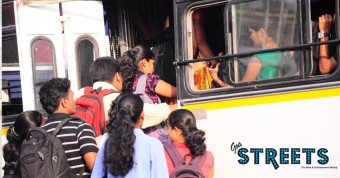A sign in hindi at Donapaula
We’re in India, After all
Is Hindi already the most spoken language in Goa, even more so than the local tongues Konkani and Marathi? In the absence of any surveys done, the verdict on this will have to be reserved. But there is no escaping Hindi wherever you go: on the beach, in beach shacks, in coastal restaurants, in the markets, in buses, and even in government offices.
So much so that it has set the alarm bells ringing, and this past week, the Goa government, in one of its most decisive acts relating to language, made Konkani or Marathi compulsory in all schools up to the 10th standard, so that the coming generations of Goans continue to speak their ‘original’ languages. And from being compulsory, Hindi has now been made the second optional language.
How all this came to be is quite a complex and interesting story, and has a lot to do with ‘identity’. Will Goans continue to cling to their Goan identity, or will we be happy being Indians first?
Sixty years ago, the first Prime Minister of India, Jawaharlal Nehru, decided that Hindi should be taught in schools all over the country as a ‘link’ language, along with English, so as to avoid the fragmentation of the country along linguistic lines. The other reason was to unite the different cultural groups and give them a sense of ‘Indian identity’.
Soon after Independence in 1947, in the early 1950’s, the states were reorganised along linguistic lines. So Marathi speaking areas were made into Maharashtra, while Gujarati speaking areas became Gujarat. And so on.
When Nehru also decided that Hindi should be taught all over the country along with English to mitigate the linguistic separations, there was large scale opposition to what many said was the ‘imposition’ of Hindi on them, Hindi being seen as the language of north Indians.
But in hindsight, linguistic experts today marvel that even in Tamil Nadu, which had most vociferously opposed Hindi, today Hindi is easily understood and spoken.
Cut to Goa. Goa became a part of India in 1961. Till then Portuguese was the official language and the language largely used in schools and higher educational institutions. That changed after Liberation in 1961 when Goa’s educational system was brought under the ambit of the Maharashtra educational system. English became the mode of education, and Hindi was made compulsory in schools. Some have accused the government of pandering to pro-Konkani constituents by reversing the longstanding policy. True or not, it seems clear the decision to make Hindi optional is a byproduct of deep-seated Goan fears of being swallowed up by giant India.
Meanwhile, Goa has become a hot tourist destination, and according to the government, 3.1 million tourists visited Goa in 2013. Of this, 2.6 million were domestic tourists from all the different linguistic regions of India. Obviously, nobody here is going to understand their local languages or mother tongues in Goa. How do all those people speaking Assamese, Manipuri, Bhojpuri, Tamil, Telugu, Kannada, Gujarati, Bengali and so on communicate when they wander around and partake of the delights in Goa?
They usually do so in Hindi because most of the work force in shacks, hotels, and almost everywhere else in Goa are migrant workers who speak reasonably good Hindi after having grown up on a diet of Bollywood potboilers. The rest have picked up a smattering of English, and a good number are now picking up Russian.
Any non-Goan who has done business in Goa’s tourism belt knows the story. Tinky, a hotelier in Baga who is originally from Mumbai, says, “Why should we speak Konkani when it’s not our mother tongue and not even convenient? Goans are not even one percent of our customers, all my staff are non-Goans because our food is non-Goan. Sure, after being in Goa for so many years, I have picked up a few words of Konkani, but I get by with Hindi because it’s the most convenient way to communicate with my suppliers and customers.”
Of course, much of this is not really literature-quality Hindi, but what is known as ‘Bombaiya Hindi’, the hotchpotch created by the Hindi of Bollywood movies meeting the regional language of a person. That’s because most Indian languages have evolved from Sanskrit, and superficially, there are a lot of similar words across different languages. For example, the numbers: ek, do, teen, etc, are quite similar across Hindi, Marathi and Konkani.
I always used to wonder why the local vegetable vendors in the market in Candolim where I live would speak to me in Hindi even though I would start the conversation in Konkani. Then one day I overheard a conversation between a vendor and another person like me, a Goan who had spent a major part of his life in Mumbai speaking Hindi most of the time. That person was speaking Konkani with a pronounced Hindi tilt; the numbers, especially, were more Hindi than Konkani. And though that person made a brave attempt to speak what he thought was Konkani (just like I was also doing to reassert my Goan identity), what was actually being spoken by him was more Hindi than Konkani! It hit me. The vendors switched away from Konkani because I came off to them as a Hindi speaker.
Strange are the twists and turns of history. A little over 50 years since the Portuguese were sent packing, barely anybody speaks Portuguese in Goa today. That’s 450 years of Portuguese linguistic legacy gone into oblivion. And now a new legacy is being created by Portugal’s successor: India itself.




